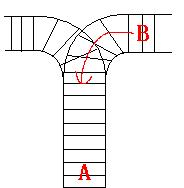E - Train Problem I
As the new term comes, the Ignatius Train Station is very busy nowadays. A lot of student want to get back to school by train(because the trains in the Ignatius Train Station is the fastest all over the world v). But here comes a problem, there is only one railway where all the trains stop. So all the trains come in from one side and get out from the other side. For this problem, if train A gets into the railway first, and then train B gets into the railway before train A leaves, train A can't leave until train B leaves. The pictures below figure out the problem. Now the problem for you is, there are at most 9 trains in the station, all the trains has an ID(numbered from 1 to n), the trains get into the railway in an order O1, your task is to determine whether the trains can get out in an order O2.

Input
The input contains several test cases. Each test case consists of an integer, the number of trains, and two strings, the order of the trains come in:O1, and the order of the trains leave:O2. The input is terminated by the end of file. More details in the Sample Input.
Output
The output contains a string "No." if you can't exchange O2 to O1, or you should output a line contains "Yes.", and then output your way in exchanging the order(you should output "in" for a train getting into the railway, and "out" for a train getting out of the railway). Print a line contains "FINISH" after each test case. More details in the Sample Output.
Sample Input
3 123 321
3 123 312
Sample Output
Yes.
in
in
in
out
out
out
FINISH
No.
FINISH
Hint
For the first Sample Input, we let train 1 get in, then train 2 and train 3.
So now train 3 is at the top of the railway, so train 3 can leave first, then train 2 and train 1.
In the second Sample input, we should let train 3 leave first, so we have to let train 1 get in, then train 2 and train 3.
Now we can let train 3 leave.
But after that we can't let train 1 leave before train 2, because train 2 is at the top of the railway at the moment.
So we output "No.".
意思是火车按顺序进入,按顺序离开,可以做到就输出做法,不能输出no,用stack就可以了,然后储存一下做法,在输出;
#include<iostream>
#include<stdio.h>
#include<stdlib.h>
#include <iomanip>
#include<cmath>
#include<float.h>
#include<string.h>
#include<algorithm>
#define sf scanf
#define pf printf
#define mm(x,b) memset((x),(b),sizeof(x))
#include<vector>
#include<queue>
#include<stack>
#include<map>
#define rep(i,a,n) for (int i=a;i<n;i++)
#define per(i,a,n) for (int i=a;i>=n;i--)
typedef long long ll;
typedef long double ld;
typedef double db;
const ll mod=1e9+100;
const db e=exp(1);
using namespace std;
const double pi=acos(-1.0);
int n;
char a[15],b[15];
vector<int>v;
stack<char>x;
bool judge()
{
v.clear();
while(!x.empty()) x.pop();
int cas=0;
rep(i,0,n)
{
while(1)
{
if(x.empty())
{
x.push(a[cas++]);
v.push_back(1);
}
if(x.top()==b[i])
{
x.pop();
v.push_back(2);
break;
}else
{
if(cas==n) return false;
else
{
x.push(a[cas++]);
v.push_back(1);
}
}
}
}
return true;
}
void display()
{
pf("Yes.\n");
rep(i,0,v.size())
{
if(v[i]==1)
pf("in\n");
else
pf("out\n");
}
}
int main()
{
while(~sf("%d%s%s",&n,a,b))
{
if(judge())
display();
else
pf("No.\n");
pf("FINISH\n");
}
return 0;
}
开心,终于又一次直接ac了
最新文章
- Quartz2D简介
- highcharts基本配置和使用highcharts做手机端图标
- spoj 416
- UITextView -- 基础备忘
- 【HTTP】Fiddler(三)- Fiddler命令行和HTTP断点调试
- 我在使用的Chrome插件
- 【C语言探索之旅】 第二部分第十课:练习题和习作
- C语言中NULL的定义
- nginx学习笔记(三)
- linux硬盘的分区、格式化、挂载以及LVM
- webpack配置模块的查找范围
- iOS之加载Gif图片
- 计蒜客 31436 - 提高水平 - [状压DP]
- English Pronunciation Analysis | Advanced English Conversation
- Spring Boot 添加JSP支持【转】
- AOP与JAVA动态代理
- subprocess.Popen命令如何隐藏弹框
- 对小组项目alpha发布的评价
- Q:WCHAR转化为CHAR
- Mysql 表锁定的问题